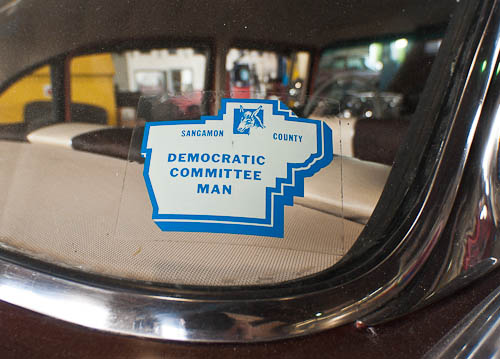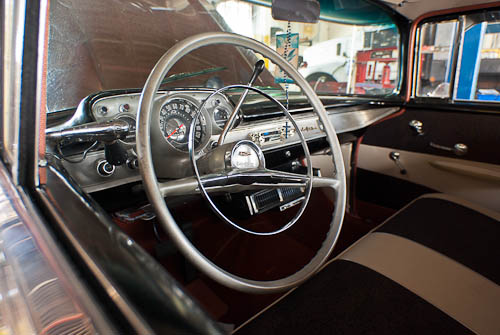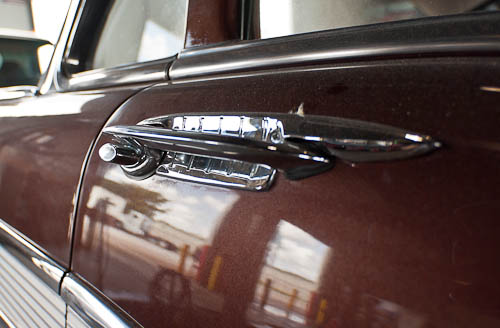I was at the repair shop, waiting for my car. One of the mechanics saw me taking pictures in the parking lot and called me over to check out this beautiful relic. The electric fan isn’t original but you can pretend it’s not there. This was a 4-door and in very nice shape overall. It had what appeared to be an authentic window sticker that read: “Sangamon County DEMOCRATIC COMMITTEE MAN”. The engine was, I think, a small V-8 (a 265? whatever the typical small block of the time was) and there was plenty of room to work under the hood. There were chrome rain gutters above the passenger windows, thick, solid sheet metal, chrome everywhere. The bumper looked like it would shatter on the most minor impact, but the playful styling made you not care. Are those breasts? It’s hard to imagine such charming curlicues on today’s cautiously styled cars, yet contemporary aesthetes decried ’50s designs as vulgar. What did they know.
UPDATE: There are some additional pics below the fold, and I’ve changed the main image to HTML so that Lex can see it on his phone.






that is so Vegas
Interesting story about the ’57 and since I am late for a dinner it was the car that was not supposed to be – but I will tell the story when I return. I think by 57 the 265 had morphed to the 283.
It’s a 283.
’56 was the last year of the 265, I believe.
RTS
My mother-in-law had a 1957 Chevy convertible. It was white and she kept it immaculate. She also never put the top down; she just liked the looks. Fortunately, when their house burned down in the 1961 Bel Aire fire (along with 476 other houses) she was in Australia and my wife, who was still a student, was driving her car. She had that car a long time and loved it.
“Several versions of a 283 cubic inch V8 were offered for 1957 (two-barrel, four-barrel carburetors, and a fuel injected version) in addition to a two-barrel version of the 265 cid V8 from previous years and the inline six cylinder.
http://en.wikipedia.org/wiki/1957_Chevrolet
Yes, those are breasts.
Ok. I read this in Automobile Magazine from Robert Cumberford – the resident retired designer. What we know as the 58 Chevy (which is hardly considered a styling icon by any imagine – in fact all of Detroit’s offerings for ’58 – save the new 4 seat “square Bird – the T Bird) – are largely forgettable in my book).
But anyway what we know as the ’58 was supposed to come out for the 57 MY – but they were late getting things together – so GM management told the designers to just freshen up the ’56 – which we know – of the 3 “Tri Year” Chevies – 55-57 – is the most desirable today of the 3 years.
Perhaps the moral of the story is that when too many designers and committees get into the act some rather boring products ensue – whereas when a model has 1 – or a few proponents =- think Zora Duntov (Corvette), Rudi Uhlenhaut (55 MB 300SL), “Butzi” Porsche – the iconic 911 who shape endures to this day – well, magical things happen.
Michael – around town here the wife of the owner of a long-established body shop (with a good reputation) tools around town in a red 57 Chevy Bel Air convertible – white top and white wall tires – and does she get attention – she has to be about 80 now.
Years ago – in the early 80s – I was working for Cessna Aircraft in Wichita KS and one weekend came across a sight so different it would almost be considered surrealistic.
Picture a lot full of tri Year Chevys – 55-57 – all Bel Airs and immaculate. It was as if you went back in time and found yourself on new car lot of a Chevy dealer.
Obviously it was a national convention of a Chevy club . Now you want to talk rare cars imagine a 57 Bel Air convertible – 283 with factory Rochester fuel injection. I think they made about 200 of those. Saw one there. It was black.
I just love a car with tits, Madmen style.
This post inspired me to see what Wikipedia had to say about the Rover V8 engine, the only V8 I’ve owned: “… originally designed by General Motors and later re-designed and produced by Rover in the United Kingdom.” …. “[it] began life as the Buick 215, an all-aluminium engine introduced in 1960 for the 1961 US model year. …The aluminium engine was relatively expensive to produce, however, and it suffered problems with oil and coolant sealing, as well as with radiator clogging from use of antifreeze incompatible with aluminium. As a result, GM ceased production of the all-aluminium engine after 1963”.
I was struck: the engine was given up because of engineering problems and then re-engineered succesfully to have a 40 year career AND WIKIPEDIA DOESN’T TELL US WHAT THE RE-ENGINEERING CONSISTED OF.
It’s odd that someone would be interested enough in car engines to produce that large entry, but not interested enough to recount the key bit of the story. I continue to find “car nuts” baffling.
Perhaps this is not so much a matter of car nuts as of Wikipedia nuts.
The 1957 cars were unusually ugly except for that Chevy. I was watching “Vertigo” the other night and Jimmy Stewart was driving a Dodge with all the geegaws that 1957 featured. I thought they were just as ugly in 1957. I can’t imagine why anyone bought a car that year.
Michael – obviously style is a subjective thing and I think i would agree with you about the 57 cars – except for GM and the Ford Thunderbird. They even tried a retro version of the T Bird in circa 2006 but got the styling all goofy. The best “retro” car in my opinion is the Mini – you know it is new and yet you can see where it came from.
Maybe the best test for styling is the test of time – and the Tri Year Chevrolets have certainly passed that test.
Look at a Chevy Nomad – a regular 55-67 Cevy that was a 2 door station wagon with some nice styling.
Look at a Pininfarina designed Ferrari from almost any year and at least to me it looks timeless.
The fact that the public apparently bought more of the equivalent Fords says they weren’t on to the styling either.
Maybe it was the Chevrolet line that has stood the test of time because a ’57 Buick or Cadillac (saw a pristine black 57 Caddy on a car lot the other day ) – well they aren’t much to look at IMO.
@Jonathan: good point.
Dearieme,
I don’t see where the Wikipedia page (http://en.wikipedia.org/wiki/Rover_V8_engine) explicitly says that it was re-engineered. I would imagine the coolant incompatibility problems were solved by forcing owners to put own-brand only coolant in (with an aluminium-friendly formulation). As for the seal problems, maybe they just used better quality seals or a different formulation of material?
I agree it would be nice to have more details on what the British engineers did to avoid the problems which caused its discontinuation in the USA. But I don’t think it’s too hard to guess.
@nicholas: “…originally designed by General Motors and later re-designed …” is what I summarised as “re-engineered”.
“I don’t think it’s too hard to guess”: well I could guess but I’d rather hoped he might tell me. If I had to guess at the motive for the strange omission, it’s that the writer was somehow ashamed that foreigners had improved the engine. Perhaps that sort of feeble immaturity is a “Wikipedia nut” weakness – as if different people didn’t improve each others’ work all the time!
‘If I had to guess at the motive for the strange omission, it’s that the writer was somehow ashamed that foreigners had improved the engine.’
Most likely the writer’s source didn’t know either. I’m also frustrated by ‘something was changed but I don’t know what’ statements.